Emilia-Romagna MotoGP insight: the race that turned everything upside down
Bagnaia ended his championship charge at Misano, while Repsol Honda scored its first one-two in more than four years and Quartararo got to wear the crown sooner than expected
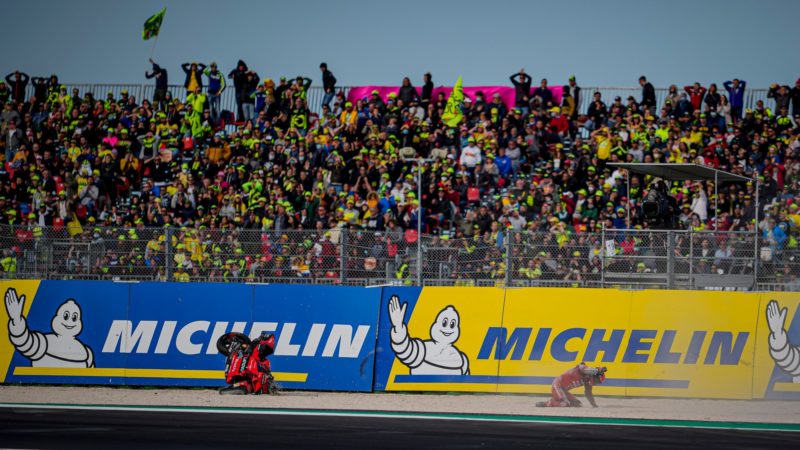
Bagnaia's championship hopes were still alive until he crashed out of the lead in the final stages at Misano on Sunday
Studio Milagro/DPPI
Halfway through Sunday’s second race at Misano it seemed like the fight for the 2021 MotoGP world championship would go all the way to the season finale at Valencia on November 14.
Title-hopeful Pecco Bagnaia was setting a blinding pace out front, while points leader Fabio Quartararo was mired in the pack, moving slowly forward from a fifth-row start, his worst qualifying performance since he arrived in MotoGP in 2019.
Quartararo looked likely to take a decent points advantage to the penultimate round at Portimao, where in April he won the race, ahead of Bagnaia, whose pole-position qualifying lap had been cancelled, leaving him to fight back from the fourth row.
Thus there was a good chance that Bagnaia would keep his title hopes alive to Valencia, where, barring disasters, Quartararo would seal the championship.
Instead the disaster was all Bagnaia’s. At Misano he had Marc Márquez for company, Honda’s six-time world champion shadowing Ducati’s main man lap after lap, but unable to get close enough to attack and slowly running out of energy.
On lap 23 of 27 Bagnaia lost the front at Turn 15, clattering into the gravel trap, just like factory Ducati team-mate Jack Miller had done 18 laps earlier, and that was that: Quartararo was 2021 MotoGP world champion.
Bagnaia’s downfall was his choice of front tyre. Five weeks earlier he had won the San Marino GP, under huge pressure from Quartararo, using Michelin’s hard option front. On Sunday he chose the same front tyre, never mind the fact that track temperature was six degrees cooler, and never mind the fact that only Bagnaia and Miller chose the hard front, while the rest of the grid opted for the medium.
Obviously both were convinced that the hard would give them an advantage, otherwise they wouldn’t have chosen it.
“The plan was always to go with the hard,” said Miller. “I made the decision at around 11 o’clock when I saw the track temperature was coming up, because we’d had quite a considerable amount of locking in a straight line with the medium, which is what happened to Jorge Martin [who locked the front into Turn 1 and crashed on lap 13].
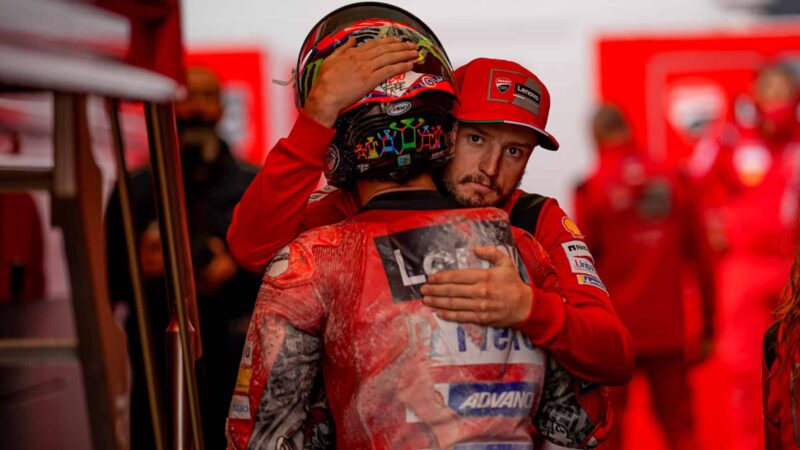
Miller consoles team-mate and fellow Turn 15 victim Bagnaia after the Italian’s title hopes ended in the Misano gravel
“It seemed like a master-stroke, the feeling was good. Around one o’clock [an hour before the start] it still looked fantastic, like it was going to be a great idea. Then when we were on the grid clouds started coming in and the track temperature was sort of borderline, so I guess it wasn’t quite warm enough.”
Misano is a clockwise circuit, with only six left-handers. Turn 15 is the first left after Turn 8, reached around 35 seconds later, so it’s imperative that riders attack Turn 8 hard, to generate enough heat in the left side of the front tyre, so it’s still got enough temperature when they arrive at Turn 15.
This was Miller’s mistake on lap four, when he was riding in Bagnaia’s wheel tracks, trying to defend the Italian’s position and help him towards taking maximum points.
“I was close to Pecco at Turn 8 that lap, so I didn’t brake as hard, didn’t force the tyre, and I think that could’ve affected the temperature in the tyre,” he added. “When I arrived at Turn 15 I had no hope of even trying to save it. Looking at the data, as soon as I put it on angle it took away from me.”
Thirty minutes later Bagnaia had pretty much the exact same accident, the front washing away from him a few metres earlier. So why did the 24-year-old Italian crash?
Throughout the race he had Márquez right behind him. The Spaniard didn’t look exactly comfortable hanging on to the Ducati, but the race leader didn’t know that. What Bagnaia didn’t want was Márquez launching a last-lap attack, because he needed every point he could get, so with ten laps to go he started pushing harder, trying to make a gap.
On lap 16 he broke the lap record, but still Márquez went with him. Finally Bagnaia’s unrelenting pace started paying dividends. From lap 19 to 22 he doubled his advantage from three tenths to six tenths. Without a doubt he was taking risks, flirting with disaster, because that’s what you have to do when you’ve only got an outside chance of winning a championship.
Finally Márquez decided to wave the white flag, because he knew he couldn’t live with the leader’s pace, and at that very moment Bagnaia asked too much of the front tyre and he was down and out.
Bagnaia was Turn 15’s last victim of the weekend. During the three days the tricky left-hander claimed no less than 19 victims.
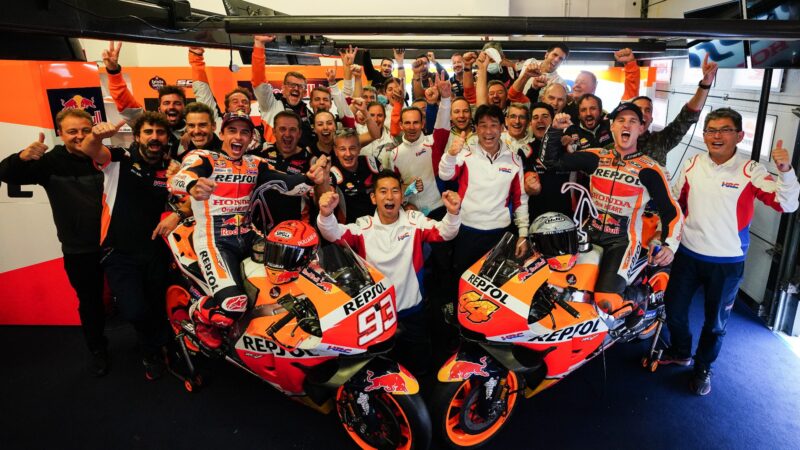
A very big deal – Repsol Honda’s first one-two since Aragon 2017 was an important breakthrough
Perhaps none of this would’ve happened if Bagnaia, Miller and everyone else had gone into the race with two days of dry practice behind them, so they could’ve done all the work they needed on set-up and tyre choice.
Instead Friday and Saturday were miserable – cold and wet, not a single dry practice session. So riders and teams had to extrapolate what they’d learned at the first Misano race and the subsequent two-day test and use that for Sunday’s race.
Ironically, the rain had seemed a much bigger problem for Quartararo. The slippery conditions made practice and qualifying a walkover for the V4s and a nightmare for the inline-fours.
In the first three practice sessions all but one of the fastest 11 riders were on V4s and in qualifying all but one of the top 12 were on V4s.
When there’s no grip the inline-four Suzukis and Yamahas can’t use the corner speed they need to make their lap time, while the more powerful Ducati, Honda, KTM and Aprilia V4s can point and squirt, teetering through the corners, then unleashing their superior horsepower on the straights.
In qualifying Quartararo was the second-best inline-four in 14th place and everyone knows how the YZR-M1 struggles to make rapid forward progress when in a pack of riders.
The weather turned out best for winner Márquez. Since he returned from his nine-month layoff at Portimao every race weekend has been a struggle. Two days of wrestling his Honda RC213V around a racetrack during practice and qualifying leaves his right arm and shoulder exhausted. But not this time. The lack of dry track was an advantage for the 28-year-old Spaniard, because it demanded much less from him physically.
“This is the first Sunday I had the energy,” he said after his 59th MotoGP victory. “I woke up and felt the arm is there, I felt power.”
Márquez’s previous 2021 victories both came at anti-clockwise circuits – Sachsenring and COTA – where the lack of strength in his right arm was less of a handicap.
Despite the relatively easy Friday and Saturday this was a huge victory for Márquez – his first success at a clockwise circuit since the 2019 Japanese GP at Motegi, nearly two years ago.
If his rivals weren’t fully convinced by his anti-clockwise victories they are certainly convinced now. Bagnaia, Quartararo and everyone else knows that if they want to win the 2022 MotoGP world championship they will have to go through Márquez to get there.
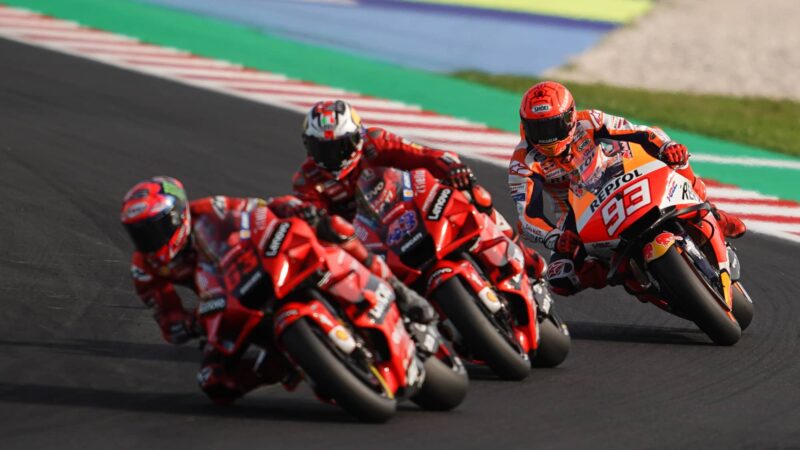
Márquez chases Miller and Bagnaia in the early laps – soon both Ducatis were in the dirt
At COTA earlier this month he said he was only suffering at three corners around the Texas circuit, whereas two weeks earlier at Misano he said he had been suffering at all but three corners. Five weeks later at Misano he was knocking on lap-record pace throughout the race, so there is no doubt that come the season-opening 2022 Qatar GP he will be at least 99% fit.
Bagnaia’s exit didn’t only promote Márquez to first place, it also promoted his Repsol team-mate Pol Espargaró to second place, the 30-year-old Spaniard’s best MotoGP result in eight years of trying and, more significantly, Honda’s first one-two since Cal Crutchlow took second behind Márquez at Phillip Island in 2019 and Repsol Honda’s first one-two since Dani Pedrosa finished second to Márquez at Aragon in 2017, more than four years ago.
Does this signal something of a turnaround for Honda and its RC213V? Possibly.
During last month’s Misano tests Márquez and Espargaró rode Honda’s hugely revamped 2022 RC213V for the first time. Of course they can’t use that bike this year but it gave them a few ideas to apply to the current RC213V.
It’s not surprising that HRC has found itself in the doldrums since last summer, because when you lose your lead rider it’s highly likely that you will lose your way. The exact same thing happened when Honda’s five-times 500cc world champion Mick Doohan was injured in 1992. When Doohan first tested Honda’s 1993 NSR500 he said the bike was all wrong and asked for his 1992-spec engine, just like Márquez asked for his 2020-spec chassis soon after his return earlier this year.
Honda’s biggest concern has been adapting to Michelin’s game-changing new rear slick, introduced at the start of last year. Without Márquez around to lead the way Honda has struggled with rear grip, both in corner exit and corner entry.
The 2022 RC213V already has more rear grip and that’s helped HRC with the 2021 bike.
“Although we can’t use the 2022 bike we got some ideas from that bike which we tried in the Misano tests, so we were better and faster,” added Márquez.
Two years ago Márquez rode the greatest premier-class season of all time – 12 victories and six second places from 18 races and a crash in the 19th, due to a technical glitch, while he was leading. This, at a time when the motorcycles have never been more equal, was a mind-boggling accomplishment.
If he can win the MotoGP championship again he will achieve grand prix racing’s greatest comeback because no other rider has come back to win again after nine months off a MotoGP bike.
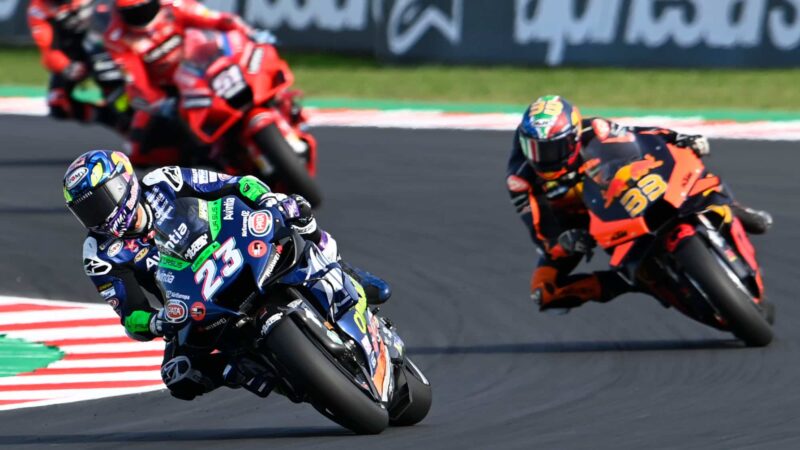
Bastianini on the charge – the Misano genius fought back from 18th on the first lap to third
The last man on the Misano podium also merits a mention.
Rookie and local hero Enea Bastianini scored his first MotoGP podium at 2021’s first Misano race and he repeated that third place on Sunday, once again mounting a remarkable fightback from a lowly grid position.
18th at the end of the first lap the 23-year-old was 12th at half-distance and fourth with four laps to go, thanks to his devilish riding and no less than eight crashes, more than a third of the grid.
Bastianini’s last victim was the new world champion, who he carved up three corners from the finish line, fully aware that Quartararo was unlikely to offer much resistance. However, the move put Quartararo into a wobble that must’ve given the entire Yamaha garage a heart-attack.
“When I saw Fabio very close on the last lap I knew I had to push over the limit,” grinned Bastianini, who had once again done the impossible on his third-hand 2019 Desmosedici.
Next year the reigning Moto2 champion is due to ride a 2021 Desmosedici, but as you read this you can be sure that his manager Carlo Pernat is on the phone to Ducati Corse management, breaking their balls for a 2022 machine.
“I think it’s impossible to receive a 2022 bike for next year,” added Bastianini. But then he grinned and added, “After this race we will check again with Gigi [Dall’igna, Ducati Corse general manger] and Davide [Tardozzi, the factory team manager] and we will go to work with my manager Carletto.”
Bastianini’s brilliant podium didn’t come without some cost on Saturday afternoon he fell three times in less than one hour, all of them at left-handers, of course: Turn 15 and Turn 2 in FP4 and Turn 6 in Q1.
“Yesterday I destroyed three bikes in eight laps,” he beamed during the post-race media conference
To bounce back to the podium from a rash of crashes like that is something special. Ducati would be wise to give Bastianini all the help it can next year.
